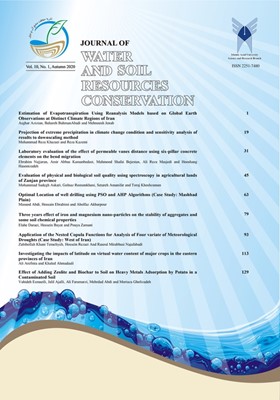Application of the Nested Copula Functions for Analysis of Four variate of Meteorological Droughts (Case Study: West of Iran)
Subject Areas : Farm water management with the aim of improving irrigation management indicators
zabihollah khani temeliyeh
1
,
Hossien Rezaie
2
*
,
Rasoul Mirabbasi
3
![]()
1 - Ph.D Student in Water Resources Engineering, Department of Water Engineering, Faculty of Agriculture, University of Urmia, Urmia, Iran.
2 - Professor, Department of Water Engineering, Faculty of Agriculture, University of Urmia, Urmia, Iran.
3 - Associate Professor, Department of Water Engineering, Faculty of Agriculture, University of Shahrekord, Shahrekord,
Iran
Keywords: Nested Copula Function, Four Variate Analysis, Modified Standardized Precipitation Index, Return Period,
Abstract :
Drought is a natural disaster and inevitable phenomenon, which should be considered preventable, but can be managed and organized. The main purpose of this study is to show how copula functions are used in the four-variable analysis of drought in the west of Iran. For this purpose, the drought characteristics, including severity, duration, inter arrival time and peak were extracted using modified Standardized Precipitation Index (SPImod). Then the frequency distributions were fitted to the mentioned drought characteristics and the best fitted marginal distribution were specified for every drought characteristics. The results showed that the gamma and exponential distributions had the best fitness on the drought severity and duration, respectively. Also, for drought peak and inter arrival time variables, the GEV function was known as the best fitted marginal distribution. In order to four variate analysis of drought characteristics, these variables were paired two by two using nested copula method. For this purpose, the fitness of nine copula functions, including Clayton, Ali-Mikhail- Haq, Farlie- Gamble- Morgenstern, Frank, Gamble, Gamble- Hougaard, Plackett, Philip Gamble and Joe were examined using Akaike Information Criterion (AIC), Maximum Likelihood (ML), and Nash-Sutcliffe Efficiency (NSE) criteria. The results showed that Joe copula is the best function for constructing the multivariate distribution in the study area. Also, this study showed that a four-variate analysis of drought provide useful information for planners and managers for drought prediction and planning to cope with drought consequences.
عباسیان، م. ص و ابریشم چی، ا. 1392. تحلیل توأم مدت و سختی خشکسالی با استفاده از توابع مفصل. پنجمین کنفرانس مدیریت منابع آب ایران، 29 بهمن دانشگاه شهید بهشتی.
میر اکبری، م و گنجی، آرمان .1391. تحلیل دو متغیره مشخصههای شدت و مدت خشکسالی هواشناسی (مطالعه موردی: کرمانشاه). مجله پژوهش آب ایران. 6 (11): 25-17
Abdi, A., Hassanzadeh, Y., Talatahari, S., Fakheri-Fard, A. and Mirabbasi, R., 2017. Regional bivariate modeling of droughts using L-components and copulas. Stoch. Environ. Res. Risk. Assess,1199-1210.
Amirataee, B., Montaseri, M. and Rezaie, H., 2018. Regional analysis and derivation of copula-based drought Severity-Area Frequency curve in Lake Urmia basin, Iran. J. Environ. Manage, 206: 134-144.
Ayantobo, O.O., Li, Y., Song, S., Javed, T. and Yao, N., 2018. Probabilistic modelling of drought events in China via 2-dimensional joint copula. J. Hydrol, 559: 373-391.
Ayantobo, O.O., Li, Y. and Song, S., 2019. Multivariate Drought Frequency Analysis using Four-Variate Symmetric and Asymmetric Archimedean Copula Functions Theor Appl Climatol, 33:103–127.
Chen, L., Singh, VP., Shenglian, G., Hao, Z. and Li, T., 2012. Flood coincidence Risk Analysis using Multivariate Copula Functions, Journal of Hydrologic Engineering 17:742-755 .
Durante, F. and Salvadori ,G.,2010. On the construction of multivariate extreme value models via copulas. Environmetrics, 21:143–161
Ganguli, P. and Reddy, M.J., 2014. Evaluation of trends and multivariate frequency analysis of droughts in three meteorological subdivisions of western India. Int J Climatol, 34(3):911–928.
Grimaldi, S. and Serinaldi, F., 2006. Asymmetric copula in multivariate flood frequency analysis. Adv Water Resource, 29(8):1155–1167.
Joe, H., 1997. Multivariate Models and Dependence Concepts, London: Chapman & Hall, 399 pp.
Kao, S.C. and Govindaraju, R.S., 2010. A copula-based joint deficit index for droughts. Journal of Hydrology, 380: 121-134.
Liu, C.L., Zhang, Q., Singh, V.P. and Cui .Y.,2011.Copula-based evaluations of drought variations in Guangdong. South China. Natural Hazards, 59(3): 1533-1546.
Mirabbasi, R., Fakheri-Fard, A. and Dinpashoh, Y., 2012. Bivariate drought frequency analysis using the copula method. Theoretical and Applied Climatology, 108.1:191-206.
Mirakbari, M., Ganji, A. and Gallah, S. R., 2010.Regional bivariate frequency analysis of meteorological droughts. Journal of Hydrologic Engineering, 15 (12): 985–1000.
Nelsen, R. B. ,2006. An introduction to copulas: Springer Verlag, New York, 215p.
Salvadori ,G. De Michele, C. and Durante,F.,2011.Multivariate design via copulas. Hydrol Earth Syst Sci Discuss,8:5523–5558.
Salvadori, G. and De Michele, C.,2004.Frequency analysis via copulas: theoretical aspects and applications to hydrological events. Water Resour Res, 40:W12511.
Shiau, J.T., Modarres, R. and Nadarajah, S., 2012. Assessing multi-site drought connections in Iran using empirical copula. Environmental Modeling & Assessment, 17: 469-482.
Sklar, A., 1959. Fonctions de répartition à n dimensions et leurs marges, Publications de l'Institut de Statistique de L'Université de Paris, 8: 229-231.
Thilakarathne, M. and Sridhar, V., 2018. Characterization of future drought conditions in the Lower Mekong River Basin. Weather and Climate Extremes, 17: 47-58
Van de Vyver, H. and Van den Bergh, J., 2018. The Gaussian copula model for the joint deficit index for droughts. J. Hydrol, 561: 987-999.
Wilhite, D.A. and Glantz, M.H.,1985. Understanding the drought phenomenon: The role of definitions. Water Int, 10(3): 111-120.
_||_

